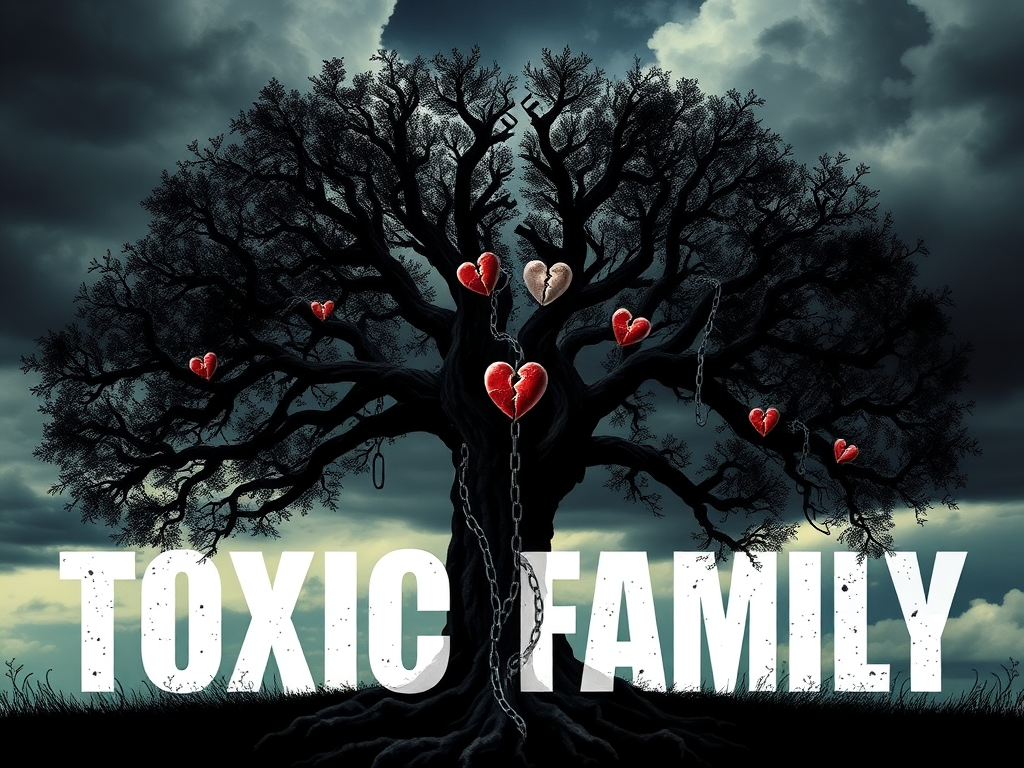When we think of family, images of love, support, and unconditional acceptance come to mind. However, for millions of people worldwide, toxic family relationships create a painful reality filled with emotional manipulation, guilt trips, and psychological abuse. Understanding toxic family dynamics is the first step toward healing and breaking free from patterns that damage mental health and self-worth.
What Are Toxic Family Dynamics?
Toxic family dynamics refer to unhealthy patterns of interaction within family systems that cause emotional damage and hinder personal growth. These dysfunctional family structures often involve manipulation tactics, emotional control, and boundary violations that leave family members feeling trapped, drained, and emotionally exhausted.
Core Characteristics of Toxic Family Systems
Toxic families share several common characteristics that distinguish them from healthy family environments:
- Emotional manipulation disguised as love and concern
- Guilt manipulation to control behavior and decisions
- Gaslighting that makes victims question their reality
- Scapegoating where one family member becomes the target
- Enmeshment with unclear personal boundaries
- Triangulation that pits family members against each other
The family environment in toxic households often feels like walking through a minefield. Family members never know when they might trigger an explosive reaction or become the target of criticism.
A Comprehensive List of Toxic Family Quotes
- “Blood is thicker than water, but some waters are better left untasted.”
- “Don’t let family members who don’t know how to love you keep you from the ones who do.”
- “Family isn’t always a place of support. Sometimes it’s a place of pain.”
- “Family can be a beautiful thing… unless they’re the ones breaking your heart.”
- “Family is supposed to support you, not bring you down. When that happens, you need to leave them behind.”
- “Family should love you unconditionally, but that’s not always the case.”
- “Family ties can sometimes be toxic cords that hold you back from becoming who you’re meant to be.”
- “Family members don’t always have your best interests at heart. Be careful who you trust.”
- “Families are supposed to be a source of comfort, but they can also be a source of pain.”
- “It’s hard to escape a toxic family, especially when they try to control your every move.”
- “It’s easier to leave an abusive relationship than it is to leave a toxic family.”
- “It’s not the love that hurts in a toxic family, it’s the manipulation.”
- “Just because someone is family, doesn’t mean they have the right to treat you badly.”
- “Toxic family members love you only when it’s convenient for them.”
- “Toxic family members will never be happy for your success; they’ll only focus on how it makes them feel inferior.”
- “Toxic family members will often manipulate you into thinking you’re ungrateful or undeserving of a happy life.”
- “Toxic families thrive on guilt and emotional manipulation.”
- “Toxic people in your family will try to keep you stuck in a place where you’re unable to grow.”
- “Toxic relationships within families are often the hardest to break because of guilt and obligation.”
- “Toxicity isn’t just about verbal abuse; it’s about emotional neglect, manipulation, and control too.”
- “You are not obligated to keep toxic family in your life just because they share your last name.”
- “You are not responsible for the actions or behavior of toxic family members.”
- “You shouldn’t feel guilty for walking away from toxic family dynamics.”
- “Your family doesn’t have to be blood to love you; real love comes from respect and kindness.”
- “Your peace matters more than keeping toxic family members in your life.”
- “Your worth is not defined by your family’s toxic behavior.”
- “A toxic family environment is one where your needs are always secondary to their expectations.”
- “A toxic family relationship will drain you until there’s nothing left to give.”
- “A toxic family member will always have a reason to justify their hurtful actions, but never an apology.”
- “A toxic family member is someone who sees your success as their failure.”
- “Being in a toxic family feels like trying to run a race with weights tied to your ankles.”
- “Being raised in a toxic family makes it hard to believe in love, trust, and healthy relationships.”
- “Family doesn’t have to be blood; sometimes it’s the people who respect you that really matter.”
- “Family is supposed to support you, not tear you down every chance they get.”
- “Family should be a source of comfort, not a source of emotional warfare.”
- “It’s okay to say no to your family’s toxic behavior.”
- “It’s not your fault that your family is toxic, but it is your responsibility to take care of yourself.”
- “Living in a toxic family is like being stuck in a cage with no way out.”
- “No matter how much you love your family, if they’re toxic, it’s okay to walk away.”
- “Toxic families are great at using guilt to manipulate and control you.”
- “Toxicity in a family can make you feel like you’re losing yourself every day.”
- “When family members manipulate your feelings for their own gain, they are no longer family.”
- “You don’t need to tolerate toxic behavior, even from family.”
- “You don’t have to stay in a toxic family just because it’s familiar.”
- “You don’t have to keep toxic family around just because of what they did for you once.”
- “Your family might have a name, but that doesn’t mean you have to accept their toxic behavior.”
- “A toxic family can make you question your worth, but remember, their opinion doesn’t define you.”
- “A toxic family often uses love as a weapon to control you.”
- “A toxic family member will never see their own faults, but they’ll point out yours at every opportunity.”
- “A toxic family member will keep you stuck in the past while you try to move forward.”
- “A toxic family will treat your boundaries like an invitation to cross them.”
- “Don’t let toxic family guilt you into silence. Your voice matters.”
- “Sometimes family is the hardest place to find unconditional love.”
- “Toxic family members will never apologize because they don’t believe they’ve done anything wrong.”
- “Toxic family members will keep you stuck in their chaos as long as you let them.”
- “Toxic families are like sharks—they’ll only respect you if you stand your ground.”
- “Toxic relationships within a family often cause more harm than relationships outside of it.”
- “Toxicity in family members is often hidden behind a mask of love and concern.”
- “Toxicity isn’t about shouting—it’s about belittling, ignoring, or controlling.”
- “When you grow up in a toxic family, you’re often made to feel that love is conditional.”
- “When you put up with toxic family members, you give them power over your peace.”
- “When you walk away from toxic family, you walk toward a healthier, happier version of yourself.”
- “You can’t heal in the same environment that made you sick, even if it’s your family.”
- “You cannot change a toxic family member. The only change you can make is to protect yourself.”
- “You shouldn’t feel guilty for setting boundaries with toxic family members.”
- “You’re not obligated to love toxic family members. You’re obligated to protect yourself.”
- “Toxic family members will make you feel like you don’t belong, but remember, you belong to yourself.”
- “Toxic people use your love to control and manipulate you.”
- “Toxic relationships are the ones that bring out the worst in you.”
- “Toxicity in a family will make you feel like you’re drowning in a sea of guilt and shame.”
- “You don’t have to keep a toxic family member in your life to prove you love them.”
- “A toxic family will never acknowledge your struggles, but they will criticize your efforts.”
- “A toxic family member is someone who sees your happiness as a threat to their control.”
- “A toxic family doesn’t just harm you emotionally; it robs you of your sense of self-worth.”
- “A toxic family doesn’t believe in personal growth; they believe in keeping you in your place.”
- “Being with toxic family feels like being constantly trapped in a cycle of emotional abuse.”
- “Family is meant to be a sanctuary, not a battlefield.”
- “Families that hurt you repeatedly will never heal you.”
- “Toxic family members will drag you down, but you don’t have to stay there.”
- “Toxic family members will always try to put you in a position where you feel like you owe them.”
- “Toxic people in your family will make you feel like you’re asking for too much by wanting basic respect.”
- “A toxic family will never treat you like you’re enough.”
- “Toxic family dynamics are the hardest to leave, but sometimes it’s the only choice you have.”
- “Your happiness matters more than holding onto toxic family relationships.”
Primary Concepts in Toxic Family Systems
Emotional Manipulation and Control
Emotional manipulation forms the backbone of toxic family behavior. Manipulative family members use various tactics to maintain control:
Love bombing followed by withdrawal creates emotional dependency. Silent treatment punishes those who don’t comply with family expectations. Emotional blackmail uses guilt and shame to force compliance.
| Manipulation Type | Description | Impact |
|---|---|---|
| Guilt trips | Making others feel responsible for their emotions | Creates chronic guilt and shame |
| Gaslighting | Denying reality and making victims question themselves | Destroys self-trust and confidence |
| Love bombing | Excessive affection followed by withdrawal | Creates addiction to approval |
| Triangulation | Using third parties to control relationships | Destroys trust between family members |
Mental Health Impact
The mental health consequences of toxic family environments are severe and long-lasting. Emotional trauma from family emotional abuse can lead to:
- Depression symptoms and persistent sadness
- Anxiety and stress from constant hypervigilance
- Identity crisis and loss of sense of self
- Attachment issues affecting future relationships
- Codependency patterns in adult relationships
- Complex PTSD from prolonged exposure to trauma
Psychological abuse within families often goes unrecognized because it’s subtle and gradual. Unlike physical abuse, emotional abuse leaves invisible scars that can take years to heal.
Relationship Types in Toxic Family Systems
Blood Relatives vs. Chosen Family
The concept of chosen family becomes crucial for those escaping toxic relationships. While blood relatives share genetic connections, chosen family members provide the emotional support and unconditional love that biological families failed to offer.
Healthy relationships are characterized by:
- Mutual respect and support
- Clear communication
- Respect for boundaries
- Emotional safety
- Encouragement of individual growth
Support Systems and Alternative Families
Building a support system outside of toxic biological families is essential for healing. Found family can include:
- Close friends who provide emotional support
- Mentors and role models
- Support group members
- Therapists and counselors
- Romantic partners in healthy relationships
Emotional States and Experiences
Negative Emotions in Toxic Families
Living in a toxic family environment generates intense negative emotions:
Guilt and shame become constant companions. Family members learn to feel responsible for others’ emotions and behaviors. Emotional pain from constant criticism and rejection becomes normalized.
Feeling trapped is common because financial dependence or cultural expectations make leaving difficult. Feeling drained occurs as emotional energy is constantly depleted by family drama and conflict.
Suffocation feelings arise from enmeshment where individual identity becomes lost in family dysfunction. Emotional exhaustion results from constantly managing others’ emotions while neglecting one’s own needs.
Positive Aspirations and Healing Goals
Despite the challenges, those affected by toxic family dynamics often develop strong aspirations for healing:
- Peace and emotional stability
- Freedom from manipulation and control
- Happiness independent of family approval
- Self-protection through healthy boundaries
- Personal growth and self-discovery
- Healing from past trauma
Key NLP Terms and Linguistic Patterns
Metaphorical Language in Toxic Family Discourse
Toxic family experiences are often described through powerful metaphors that capture the emotional reality:
Nature metaphors like “rotten roots” and “storm cloud” describe the fundamental corruption and persistent negativity. Structural metaphors such as “cage,” “battlefield,” and “war zone” convey the trapped and combative nature of these relationships.
Movement metaphors including “walking on eggshells” and “weights tied to ankles” express the constant vigilance and impediments to progress. Water metaphors like “drowning in guilt” and “sea of guilt and shame” illustrate the overwhelming nature of negative emotions.
Semantic Fields and Relationship Dynamics
The language around toxic families reveals three primary semantic fields:
Control and Manipulation encompasses terms like manipulation tactics, gaslighting, emotional abuse, and power dynamics. This field represents the tools toxic family members use to maintain dominance.
Emotional Impact includes words like drain, suffocate, tear down, belittle, criticize, and neglect. These terms describe the destructive effects on victims.
Relationship Dynamics explores tensions between loyalty vs. self-preservation, conditional vs. unconditional love, and expectations vs. boundaries.
Sentiment Analysis and Empowerment Language
Negative Sentiment Markers
Toxic family discourse contains strong negative sentiment markers:
- Absolute terms like “never” and “always” that express totality of negative experience
- Destructive verbs like “drain,” “tear apart,” and “suffocate”
- Emotional pain words including “guilt,” “shame,” “pain,” and “chaos”
Empowerment Language for Healing
Recovery-oriented language emphasizes empowerment and choice:
- Permission phrases: “it’s okay to,” “you deserve,” “you are not obligated“
- Action-oriented terms: “protect yourself,” “set boundaries,” “walk away“
- Self-worth affirmations: “your worth,” “your peace,” “your happiness“
Named Entity Recognition Categories
Person Categories in Toxic Family Systems
Toxic individuals within families often fall into recognizable categories:
- Narcissistic family members who demand constant attention
- Toxic parents who use children to meet their emotional needs
- Manipulative relatives who create drama and conflict
- Enablers who protect toxic behavior
- Flying monkeys who carry out the toxic person’s agenda
Abstract Concepts and Behavioral Patterns
Understanding the abstract concepts involved helps identify toxic family patterns:
Mental health conditions like narcissistic personality disorder, borderline personality disorder, and antisocial personality disorder often drive toxic behavior.
Behavioral patterns include criticism patterns, blame shifting, victim blaming, and enabling behavior. These patterns create predictable cycles of abuse and dysfunction.
Discourse Markers and Pragmatic Elements
Speech Acts in Toxic Family Communication
Toxic family members use specific speech acts to maintain control:
- Warnings disguised as concern: “You’ll never survive without us”
- Guilt-inducing statements: “After everything we’ve done for you”
- Invalidation: “You’re too sensitive” or “That never happened”
- Threats: “If you leave, don’t ever come back”
Healing-oriented discourse uses different speech acts:
- Validation: “Your feelings are valid”
- Permission: “It’s okay to walk away“
- Encouragement: “You deserve healthy relationships”
- Affirmation: “You are enough”
Thematic Semantic Networks
Core Theme Clusters
Four primary thematic networks emerge in toxic family discourse:
Toxicity → Control → Manipulation → Guilt represents the progression of toxic behavior from general negativity to specific control tactics.
Family → Blood → Obligation → Loyalty shows how family bonds are weaponized to maintain toxic relationships.
Healing → Boundaries → Self-care → Freedom traces the recovery journey from recognition to liberation.
Love → Respect → Support → Unconditional describes the characteristics of healthy relationships that contrast with toxic dynamics.
Signs of Toxic Family Behavior
Manipulation Tactics and Red Flags
Recognizing toxic family behavior patterns is crucial for self-protection:
Love bombing creates artificial highs followed by devastating lows. Gaslighting family members deny reality and make victims question their memories and perceptions.
Family guilt trips use emotional manipulation to control decisions. Silent treatment punishes those who don’t comply with family expectations.
Triangulation involves bringing third parties into conflicts to avoid direct communication. Scapegoating designates one family member as the source of all problems.
Emotional Abuse Indicators
Family emotional abuse often includes:
- Constant criticism that undermines self-esteem
- Emotional withholding as punishment
- Invalidation of feelings and experiences
- Boundary violations that ignore personal limits
- Enmeshment that prevents individual identity development
LSI Keywords and Related Concepts
Abuse Types and Psychological Concepts
Emotional abuse, psychological abuse, verbal abuse, and mental abuse represent different forms of non-physical harm within families. Childhood abuse and parental abuse specifically affect developing minds and create lasting trauma.
Generational trauma passes down through family lines, perpetuating toxic patterns. Intergenerational trauma affects multiple generations simultaneously.
Psychological concepts like codependency, enmeshment, triangulation, scapegoating, and golden child syndrome describe specific dynamics within dysfunctional families.
Recovery Terms and Healing Approaches
No contact and low contact represent different approaches to protecting yourself from toxic family. The gray rock method involves becoming uninteresting to avoid toxic attention.
Family therapy, individual therapy, support groups, and self-help resources provide professional support for healing. Recovery programs and healing techniques offer structured approaches to recovery.
Healing from Toxic Family Trauma
Setting Boundaries with Toxic Family
Setting boundaries with toxic family members is essential for mental well-being. Healthy boundaries protect emotional energy and prevent manipulation.
Types of boundaries include:
| Boundary Type | Description | Examples |
|---|---|---|
| Physical | Limiting physical contact and proximity | No hugs, separate living spaces |
| Emotional | Protecting emotional energy | Not discussing personal matters |
| Time | Controlling when and how long to interact | Limited visit duration |
| Communication | Choosing how to communicate | Email only, no phone calls |
| Information | Controlling what information to share | Not sharing personal achievements |
Building Self-Worth and Identity
Self-worth development requires separating your value from family opinions. Self-esteem building involves recognizing your inherent worth regardless of family approval.
Identity crisis is common when separating from toxic families because identity was never allowed to develop independently. Self-validation becomes crucial when family validation was conditional or absent.
Personal growth accelerates once toxic influences are removed. Self-empowerment comes from making independent decisions based on personal values rather than family expectations.
Creating Healthy Relationships
Characteristics of Supportive Relationships
Healthy relationships contrast sharply with toxic family dynamics:
- Emotional support without conditions or expectations
- Nurturing relationships that encourage growth
- Caring relationships based on mutual respect
- Loving relationships that accept imperfections
- Supportive relationships that celebrate successes
Finding Your Chosen Family
Chosen family relationships often provide what biological families couldn’t:
Found family members offer unconditional love without the baggage of shared history. These relationships develop naturally based on mutual affection and respect rather than obligation.
Building chosen family requires:
- Identifying people who consistently support your well-being
- Developing deep, meaningful connections over time
- Creating new traditions and shared experiences
- Establishing mutual support systems
- Celebrating each other’s growth and achievements
Long-Term Recovery Strategies
Professional Help and Support Systems
Seeking professional help is often necessary for healing from toxic family trauma. Trauma specialists understand the complex dynamics of family dysfunction and can provide targeted interventions.
Family counseling services may be beneficial if family members are willing to change, though this is often not the case with truly toxic individuals. Individual therapy focuses on healing personal trauma and developing coping strategies.
Support group meetings connect you with others who understand the unique challenges of toxic family relationships. Crisis intervention services provide immediate help during particularly difficult periods.
Coping Strategies and Emotional Regulation
Stress management techniques help manage the ongoing effects of toxic family exposure. Emotional regulation skills enable healthy responses to triggers and difficult emotions.
Effective coping strategies include:
- Mindfulness practices that anchor you in the present moment
- Self-care routines that prioritize your physical and emotional needs
- Personal development activities that build new skills and interests
- Empowerment exercises that reinforce your right to happiness and peace
- Independence building that reduces reliance on toxic family members
Breaking Toxic Family Cycles
Creating New Patterns for Future Generations
Breaking toxic cycles prevents passing dysfunction to children and future generations. This requires conscious effort to develop new ways of relating and communicating.
Key steps include:
- Recognizing toxic patterns from your family of origin
- Learning healthy communication and conflict resolution skills
- Developing emotional intelligence and empathy
- Creating safe, nurturing environments for children
- Seeking help when old patterns emerge
Moving Forward with Hope
Personal empowerment comes from recognizing that you have choices, even when those choices are difficult. Walking away from toxic family is often the most loving thing you can do for yourself and future generations.
Remember that healing is a process, not a destination. Recovery from abuse takes time, patience, and often professional support. However, millions of people have successfully broken free from toxic family dynamics and created fulfilling lives filled with healthy relationships and unconditional love.
Conclusion
Understanding toxic family dynamics is the first step toward healing and creating the life you deserve. While family toxicity can cause deep wounds, recovery is possible with the right support, boundaries, and commitment to your own well-being.
Your mental health and emotional well-being matter more than maintaining toxic relationships, even with family members. You deserve relationships based on respect, support, and unconditional love. Whether that comes from biological family or chosen family, you have the right to surround yourself with people who truly care about your happiness and growth.
The journey from toxic family trauma to healing is challenging but ultimately rewarding. Each step toward healthy boundaries, self-worth, and emotional freedom brings you closer to the peace and happiness you deserve. Remember, you are not alone in this journey, and help is available when you’re ready to reach for it.

Catherine Frank, founder of BiblicalHorizon.com, shares daily prayers and Bible verses to nurture spiritual growth. With a lifelong passion for scripture and prayer traditions, she creates accessible spiritual content that resonates with both seasoned believers and newcomers seeking divine connection.



